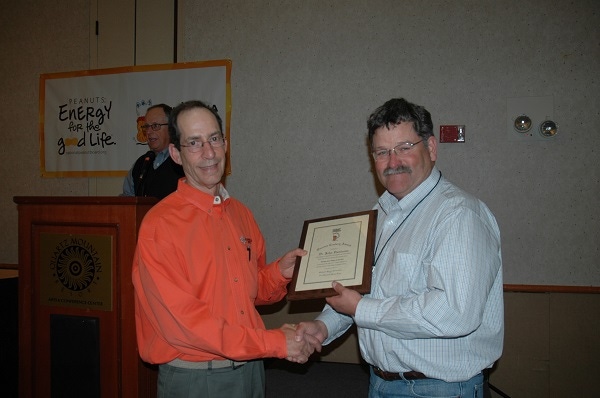
Knowing the field history is a crucial factor in controlling diseases, especially soil-borne pathogens, in peanuts.
Rotation, scouting, variety selection, proper fungicide use and scheduling protective applications also play important roles, says Oklahoma State University Extension plant pathologist John Damicone.
Damicone reviewed peanut disease control recently at the annual Oklahoma Peanut Expo at the Quartz Mountain Resort near Lone Wolf, Okla.
He said field history is especially important for soil borne disease and nematode infestations. “We are seeing more nematode problems,” he said. “Our best bet has been rotation, two to three years out of any legume crop.”
He also noted that knowing which market types are more susceptible to specific disease organisms helps peanut producers make informed decisions about what to plant where and how to manage runners, Virginias and Spanish varieties.
For the latest on peanut and other crop issues, please check out Southwest Farm Press Daily and receive the latest news right to your inbox.
Leaf spot, for instance, may be hard on Spanish and runner types. Runners are also susceptible to sclerotinia and pod rot. Virginias are vulnerable to pod rot and sclerotinia, particularly with a history of the disease in the field.
A 14-day spray schedule is still routine for leaf spot control, Damicone said. “That’s typically six spray applications. A reduced program of three applications (climate-based) is a possibility and seems to work best with runner peanuts.”
Controlling early leaf spot is important, he added, to reach high yield goals. “We need to prevent plant defoliation and get into September with leaves intact.”
Fungicides for leaf spot control are preventive, Damicone said. “They work like a coat of paint to protect the leaf against infection. We can’t cure leaf spot. If we wait until we see leaf spot on the plants, we will get damage.”
He said plants may be infected two weeks before symptoms appear.
Weather trends also affect leaf spot occurrence. “In 2013, rainfall was variable across our peanut production area,” Damicone said. “In central and eastern Oklahoma, we had abundant rain and we saw some leaf spot pressure.”
Farmers have several fungicides available for leaf spot including Headline, Bravo, Tilt, Folicur, Provost, Fontelis, Abound, Priaxor, Moncut, Equus and MCW.
“Depending on the product, leaf spot control trials show that fungicide application resulted in up to a 1,500 pound per acre yield advantage,” Damicone said.
Leaf spot control pays
Over several years, trials show a 500-pound average advantage of controlling leaf spot. “In dry years, we see little gain, but in a wet year we get more than a 1,000-pound advantage. It is important to control leaf spot with a high yield goal.”
Damicone said other control techniques are under consideration or in use. A leaf spot advisory program using Mesonet data to indicate likelihood of conditions favoring leaf spot infection may help farmers decide on control options. “It’s also important to get into the field. Scout and know the field,” he said.
Managing the primary soil-borne diseases also requires knowing the field, Damicone said. “Base control strategy on field history. Infection may occur from mid-season (mid-July) until mid-September. “If a farm has problems, it pays to control.”
He said pod rot “is hard to deal with, but we do have good fungicides—Abound and Ridomil. Calcium fertility and variety resistance also help.”
He said Virginia types are vulnerable to pod rot.
Controlling Sclerotinia blight begins with evaluating field history, Damicone said. “Also look at variety selection and fungicide options. With Virginia peanuts or a history of Sclerotinia in the field, use a fungicide or risk severe yield reductions. Treat based on symptoms; apply a fungicide when you first see symptoms. The disease may come in from July through September.”
Fungicide choices include Omega, Endura, Propulse and Fontelis. He said Omega and Endura “generally provided the best disease control. Most treatments numerically increased yields, compared to the untreated check.”
He said one plot with severe deer damage provided limited data.
Damicone is also looking at response to numerous breeding lines to fungicide programs.
He summarized disease management trials in a publication “Peanut Research at OSU 2013.”
Findings included:
New fungicides Fontelis and MCW 710 provided excellent leaf spot and southern blight control, resulting in yield response of more than 1,000 pounds per acre on Spanish peanuts.
Two fungicides recently registered for peanuts (Fontelis and Propulse) did not have consistent activity against Sclerotinia blight when applied alone or in alternation with each other, compared to Omega and Endura.
Under low pressure from Sclerotinia blight, the varieties Florida-07 and Red River Runner produced the highest yields and crop value ($ per acre).
Runner (ARSOK-R30) and Spanish (ARSOK-S140-10L) breeding lines from the USDA/ARS breeding program showed excellent resistance to Sclerotinia blight and had the highest yields and grade.
Calendar (six applications) and weather-based (three application) programs increased yields of Spanish peanuts by more than 1,000 pounds per acre where early leaf spot was severe.
Integrated approach critical for resistant weed control
Damicone said farmers should consider all the disease management tools available, beginning with rotation and field history in making disease control plans for any year. And protection remains the key for leaf spot.
Also of interest:
Ole Spanish peanut fills a niche
USDA amendment would add Arkansas as Primary Peanut-Producing State
About the Author(s)
You May Also Like






